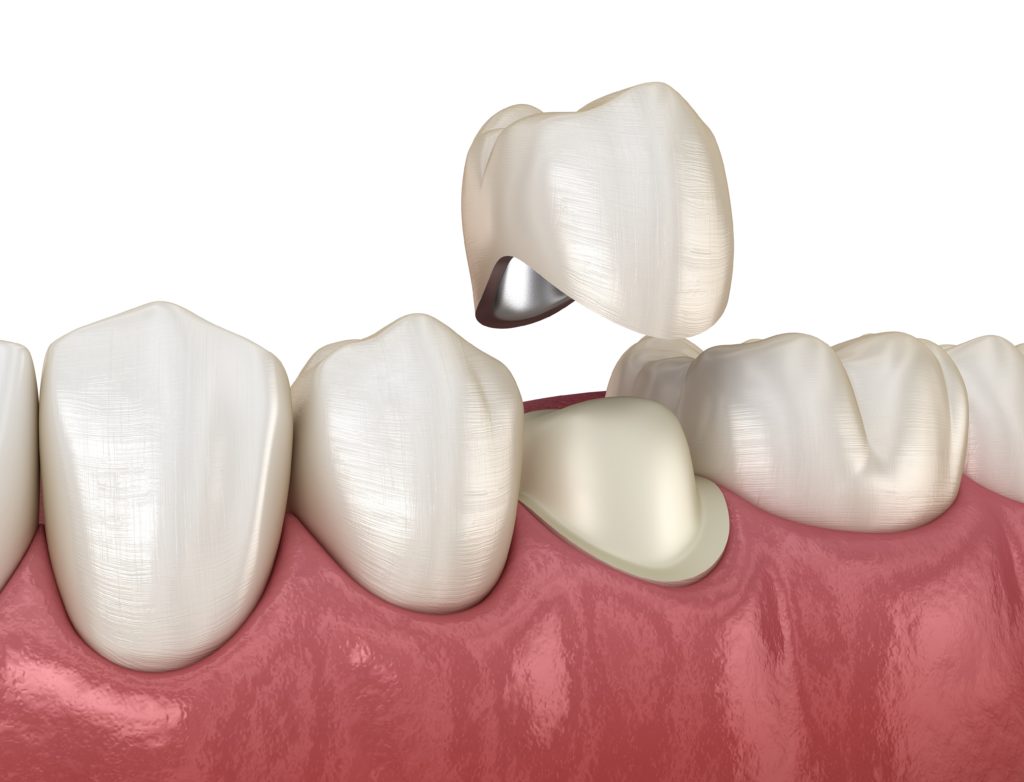Prostheses
By Dr. Andrea Belcuore
Dental crowns
What are they??
Dental crowns are prostheses that cover damaged, broken, or otherwise compromised teeth, strengthening them in order to ensure their functionality and aesthetics.
They are applied when the tooth is still recoverable, and it is not yet necessary to extract and replace it with an implant.
Current techniques and the latest materials make it possible to create crowns that are very similar to real teeth.
Materials for Constructing Dental Crowns
Different materials are used for constructing dental crowns.
Metal-ceramics
Metal-ceramics were once an almost compulsory choice. Today they are increasingly replaced by zirconium (or zirconia) crowns and lithium disilicate crowns.
The classic METAL-CERAMIC crowns consist of two layers: a metal cap on which a layer of ceramic is applied.
They continue to be an optimal solution and a guarantee in terms of resistibility, but they are not the best solution aesthetically: over time a gingival retraction can occur that reveals the margin of the crown with its metal edge, which is thus visible between the tooth and the gum. In addition, the presence of a metal layer underneath hinders the passage of light through the crown, thus giving it an unnatural and different appearance compared to that of neighboring teeth.
They are an excellent option in the back areas of the mouth, less visible in the smile. They are more expensive, especially if noble metal castings, such as gold, platinum and palladium, are used.
Zirconium
Zirconium (or zirconia), as it is called in dentistry, the more precise term being zirconium oxide, has characteristics that are highly appreciated in the production of dental crowns: a particularly hard and bright mineral ceramic, it represents an alternative to traditional metal-ceramic crowns, guaranteeing resistance but also offering excellent aesthetics, due to its translucency which provides an appearance very similar to that of natural teeth. In addition, it is one of the most biocompatible materials used the creation of dental crowns.
Monolithic zirconium oxide
Monolithic zirconium oxide bridges can also be made. This is made possible by the fact that it is a suitable material for milling, giving optimal aesthetic results, especially in terms of translucency. In addition, its flexural strength and resistance to breakage is remarkable, also allowing ceramic thicknesses of up to 0.6 millimeters, in case where the aesthetic value is enhanced by building double-layer crowns: zirconium and ceramic. Zirconia prosthetic elements are increasingly being manufactured using CAD/CAM technology.
Lithium Disilicate
LITHIUM DISILICATE is the material that today is best able to combine resistance, functionality and aesthetics, especially when repairing single crowns or small bridges. It has a strong aesthetic value and requires a slimmer base than the other 2 types of material; Therefore, it allows makes it possible to preserve as much tooth tissue as possible.
How Dental Crowns Are Applied
This takes place in two sessions. During the first one, the dentist prepares the tooth so that it is suitable for the shape of the crown. The tooth is partially filed, removing a part of its damaged part and creating a truncated pyramid shape, so as to create the space for the application of the crown.
Subsequently, an impression is takenfor the creation of the crown, to be built by a specialized lab technician. In the meantime, a provisional one is applied. In a second session, the final crown will be applied and cemented with an adhesive material.


